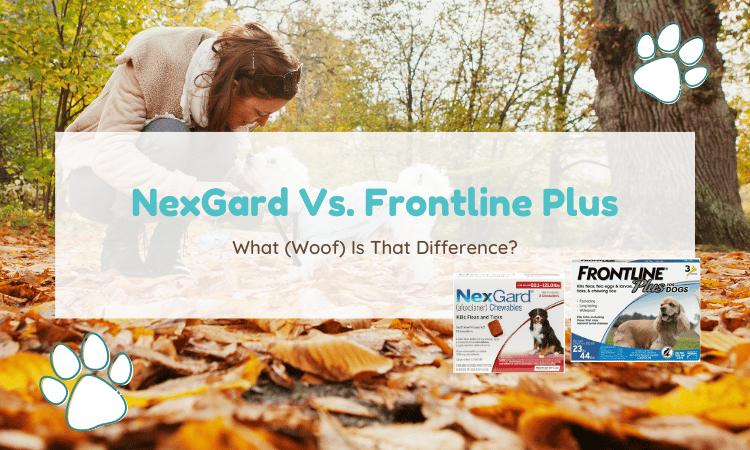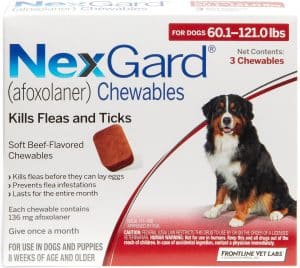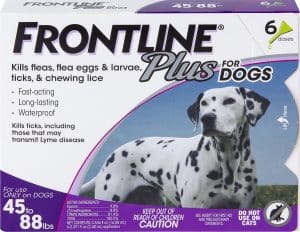With the huge array of parasite medications available both online and at your pet store what should you choose? Is it safe to use a product that you purchased from somewhere other than your veterinarian? Don’t worry, Fluent Woof has your back as we check out two products in this review. NexGard vs Frontline Plus, which should you choose?!
Both of these products have been on the market for over 5 years and approved for use in pets to prevent and treat infestations by a range of pesky parasites. In this NexGard vs Frontline Plus review, we give you a comprehensive guide on both products to help you make the best choice for your pooch.
What Do NexGard and Frontline Plus Do?

This is the $64,000 question, what are these products actually meant to do?! Both products are approved to treat and prevent flea and tick infestations in pet pooches.
NexGard For Dogs Review
Merial Animal Health (now part of Boehringer Ingelheim) launched NexGard in 2013 as a novel oral flea and tick preventative. Then in 2018 NexGard was approved as the only product licensed (at the time of writing) to prevent Lyme disease in treated pets through its action against the black-legged/deer tick that can transmit this nasty disease.
NexGard Spectra has the added benefit of an extra ingredient to treat and protect pets against intestinal and heartworms. This product isn’t available in the US at the moment, so we won’t go in-depth in this review. Check out our in-depth review on NexGard for more information on both products.
Application:
NexGard is available in a tasty beef-flavored chew that you simply give to your pooch either as a treat or mixed with their usual food.
What does it kill?
The active ingredient, afoxolaner kills both fleas and a number of different tick types. Targeting adult fleas before they have the opportunity to lay eggs in your pet’s coat while ticks are killed as soon as they attach to your pooch for a meal. Studies have also shown that NexGard can treat demodectic and sarcoptic mange infestations
How does it work?
Afoxolaner (the active ingredient in NexGard) is a member of the isoxazoline family of ectoparasiticides and acts by blocking communication between nerve cells in the target bug causing over-excitation of the nervous system and their subsequent death.
How long does it last for?
Each NexGard chewable protects your pupper against fleas and ticks (and mange) for 30 days. The product is available in weight-based doses for easy administration to your pooch.
What Are the Active Ingredients in NexGard
Afoxolaner: This ingredient is 100% effective against fleas with over 90% efficacy against ticks.
How Are the Ingredients in NexGard Delivered?
As NexGard is an oral product, the chew needs to be digested and its ingredients absorbed into your pooch’s blood stream through their small intestine. The active ingredient is then stored beneath the pet’s skin until the parasite bites, they then ingest a lethal dose of the product.
How long does it take for NexGard to start working?
NexGard starts to work within just 4 hours and will kill all fleas that bite your pooch within just 8 hours. Fleas are killed so rapidly, they don’t have the chance to lay eggs in your pet’s fur and NexGard is 100% effective against fleas within just 24-hours. Ticks take a little longer, with over 90% effectiveness being reached within 72-hours while also protecting against the transmission of Lyme disease to your pet from deer and black-legged ticks.
Safety, Risks and Possible Side Effects
We all know that no product is 100% safe for every pet, it’s important to be informed about any risks before you give anything to your pet. As always, please consult with your veterinarian before administering any new product to your fur-baby.
NexGard has been shown to be safe for all breeds of pets over 4lb weight and is even suitable for elderly pooches, or those taking medications. As this product is an oral chew, you don’t need to worry about separating your pet after administration of their parasite treatment.
Sounds great right? There are some side effects though thankfully these are uncommon.
Vomiting/Diarrhea/Reduced appetite: Gastro-intestinal distress are the more commonly reported adverse effects to this medication but are usually short-lived and generally don’t require any intervention aside from a bland diet for a few days.
Itching or allergic skin reactions including hives: These are uncommon and can usually be treated with anti-histamines or less commonly, a stronger medication. If your pup experiences any of these signs then you should contact your veterinarian as soon as possible.
Lethargy: Some owners report short-term lethargy and fatigue in their pet after administering the chewable treatment but this passes quickly and your pet should be back to normal in no time.
Caution for pets with a history of seizures or other neurological disorders! While NexGard has been proven safe for pets at up to 5 times the recommended dose there have been some reports of neurological signs including ataxia (drunken walk), restlessness and even seizures, these are all exceptionally rare. While these are rare, it’s best to err on the side of caution and only use this product under the supervision of your veterinarian or avoid its use in those with neurological problems.
What we like about it
- Safe to use in pets over 8 weeks old once they weigh at least 4lbs. This includes elderly pets or those taking medications for other conditions
- Fleas start to die within just 4 hours after administration
- The only product approved to prevent Lyme disease by killing the tick vectors
What we don’t like about it
- Seizures are a possible side effect of the active ingredient, though thankfully very rare
Our Rating: 4 out of 5 stars! No product is 100% perfect and NexGard is no different, it’s very effective against fleas and ticks with added protection against mange.
NexGard is also the only product licensed to prevent the transmission of Borrelia burgdorderi, the bacterium that causes Lyme disease. This is achieved by killing the black-legged and deer ticks that carry this bacterium. While neurological side effects are very rare they can be significant and traumatizing for both paw-rent and fur-baby.
As a prescription-only product, your veterinarian will be able to monitor and advise you about your pet’s risks of adverse effects and take every precaution to protect your pupper.
Frontline Plus For Dogs
Frontline Plus is possibly one of the best known flea and tick treatments on the market. Also produced by Merial Animal Health (now part of Boehringer Ingelheim), Frontline Plus burst onto the market in 2016 as an enhancement to the original Frontline formulation. Frontline Plus has the benefit of including flea eggs and larvae in their targeted bugs.
Application:
A topical medication, these pre-measured pipettes are easily applied to the skin between your pooch’s shoulder blades. Simply snap the top off, part your pet’s hair and squeeze the liquid onto their skin.
What does it kill?
Fleas and ticks remain the target of Frontline Plus, as with the original Frontline formulation. The addition of an insect growth regulating compound, (s)-methoprene also targets the juvenile life stages and eggs of fleas to break the re-infestation cycle.
How does it work?
Each pipette contains a measured dose suitable for your pet’s weight and the liquid within is rapidly absorbed into the skin. The active ingredients then concentrate within the hair follicles on your pooch’s coat where it is then slowly released into the fur over the following month.
How long does it last for?
Frontline Plus protects your pooch from fleas and ticks for 30 days after each topical application.
What Are the Active Ingredients in Frontline Plus?
Fipronil: This ingredient kills adult fleas and ticks
(S)-Methoprene: This ingredient prevents flea eggs, pupae and larvae from developing to the next life stage.
How Are the Ingredients in Frontline Plus Delivered?
The carrier liquid that you apply to your pet’s skin is rapidly absorbed. Once a flea or tick makes contact with their fur the ingredients get to work. Fipronil acts on the parasite’s nervous system causing their death while (s)-methoprene acts like an insect hormone where it hinders growth and development of the juvenile phases to the next developmental stage.
How long does it take for Frontline Plus to start working?
Fleas start to die within just 4 hours after the application of Frontline Plus to pets and up to 100% of fleas are dead within just 12 hours! Ticks start to die within 24-48 hours of treatment, in fact one study found that fipronil has up to 100% efficacy against the brown-dog tick (Rhipicephalus sanguineus) (1).
Safety, Risks and Possible Side Effects of Frontline Plus
As with other products, side effects are possible though luckily rare. Most adverse effects tend to be mild and are rapidly resolved without intervention.
Skin reactions: Mild redness or itchiness of the application site are the most commonly seen signs but these are usually transient and gone within 24 hours.
Vomiting/Diarrhea: These signs tend to be seen if a pet ingests the product and again are luckily rare and can be prevented by proper application and separating treated pets from others until the liquid has absorbed.
What we like about it
- Suitable for pregnant and lactating bitches
- Fast-acting, within just 4 hours
- Rapid tick killing activity within 24-48 hours
- Water-proof
What we don’t like about it
- Reports of resistance to fipronil have been emerging
Our Rating: Another 4 out of 5 product! The reports of flea resistance to fipronil have been emerging and are of concern for the future efficacy of Frontline Plus, but currently this is unlikely to affect most pets at the moment. Many owners report seeing more fleas on their pet after application which leads them to believe it’s not working but this isn’t so.
Fleas move away from a pet’s skin once they’ve been exposed to the active ingredients and are dying so it’s actually good to see “more fleas” following treatment as this indicates it’s working. Another great benefit to Frontline Plus is that the active ingredient, fipronil) becomes even more toxic to parasites when exposed to summer sunlight, which is exactly when you need the strongest flea-killing power.
As always, only use any treatment for fleas and ticks under the direction of your pet’s veterinarian. Any pet can experience an adverse reaction to a product so if your pet shows any concerning signs after treatment then you should contact your veterinarian as soon as possible for advice.
NexGard vs Frontline Plus: What Are the Differences?
Some obvious differences jump out between these products so let’s have a look…
Target species: Both products target fleas and ticks but NexGard kills only adult fleas and has no activity against eggs, pupae nor larvae. Conversely, Frontline Plus prevents development of eggs and larvae into the next life stage to break the cycle of emergency re-infestation. NexGard is also effective against both demodectic and sarcoptic mange and is the only product approved to prevent Lyme disease infection through its action against black-legged/deer ticks.
Application: This is a clear difference with NexGard being a tasty beef-flavored chew that’s absorbed through the gastrointestinal system while Frontline Plus is a topical, “spot-on” application absorbed through a pooch’s skin.
Delivery of Ingredients to Pests: NexGard requires the parasite to bite your pet in order to receive a fatal dose while Frontline Plus kills on contact, meaning fleas don’t even need to bite your pooch to be killed.
NexGard and Frontline Plus Similarities
What makes NexGard and Frontline Plus comparable? Read on to find out…
Duration of Action: Both products persist in treated pet’s systems for 30 days.
Speed of onset of Action: Both Frontline Plus and NexGard have been shown to start killing fleas within 4 hours of administration.
NexGard vs Frontline Plus: Effectiveness
These products are both effective against their targets of fleas and ticks. Both have a rapid onset of action and kill up to 100% of fleas within 24-hours of application.
NexGard is the only product proven to prevent infection with the bacterium that causes Lyme disease by killing its vector tick but NexGard’s efficacy against ticks takes up to 72 hours to kill over 90% and requires bugs to bite to be killed.
Conversely, Frontline Plus kills ticks within 24-48 hours and the active ingredient, fipronil, has been shown to kill 100% of the brown-dog tick (this isn’t the Lyme disease vector tick though).
NexGard vs Frontline Plus: Which Is Safer?
Both of these products are generally considered safe for the majority of pooches, with adverse effects being uncommon.
The active ingredients that kill fleas and ticks act on the bugs’ nervous systems and overdose with either product could affect a dog but safety studies have shown this takes concentrations that far exceed those within the products. To prevent any adverse effects, always weigh your pet to ensure accurate dosing and only use products under the supervision of your veterinarian, including non-prescription products like Frontline Plus.
There’s a huge amount of scary information on the internet about NexGard causing seizures in pets and while it is a possible side effect, this is an extremely rare occurrence. It’s safe to prescribe NexGard to some patients though I avoid it in pooches with a history of epilepsy, seizures or other neurological disorders. Your veterinarian is best placed to fully advise you about your pet.
Ease of Use
Both of these products are easily administered monthly. NexGard is a tasty beef-flavored chew that most pets eagerly munch when offered but if you’re pet is fussy you can mix the chew with their usual food or in their favorite treat.
There are the occasional extra picky pooches that refuse to eat these chews under any circumstances and in these, a topical product may be easier to administer.
Frontline Plus is another easily administered product, simply squeeze the contents of the ampoule onto your pet’s skin. If you have a particularly wriggly chap this may take two people to ensure your pet receives an appropriate dose.
Which Scores Better on Price?
As with all products, the size of your pooch will dictate the cost of treatment, so we’ve compared NexGard “Blue box” containing 3 treatments for pets weighing 10.1-24lbs with Frontline Plus, 3 pipettes for dogs weighing 5-22lbs.
NexGard “Blue box” costs around $62 for 3 chews which equates to just over $20 per month. Frontline Plus 3 pipette pack for a pet of similar size costs in the region of $35, so that comes out to around $11 per month.
It’s important to remember one major difference between these products, NexGard requires a veterinary prescription to purchase while Frontline Plus is available over-the-counter; this does impact the price to some degree.
Does My Dog Really Need Flea & Tick Medication?
Yes, all dogs NEED flea and tick prevention and treatment medication. These bugs transmit nasty diseases including Leishmaniasis, Lyme disease and Rocky Mountain Spotted Fever so killing the transmitting vector helps to prevent infection of pets with these illnesses. Parasite infestations can even cause anaemia in some pets, particularly puppies and smaller dogs.
F.A.Qs
Q: Can I use NexGard or Frontline Plus more than once a month?
A: No, both products should only be applied once per month. If you’re concerned that your pet’s medication hasn’t worked then you should contact your veterinarian in the first instance for advice.
Q: Do fleas and ticks have to bite my pet for NexGard or Frontline Plus to work?
A: NexGard does require these parasites to bite in order to be exposed to the active ingredient while Frontline Plus kills pests on contact with your pet’s fur and doesn’t require them to bite your pooch.
Q: My puppy is only 4 weeks old. Can I still use NexGard Or Frontline Plus?
A: No, neither of these products are suitable for puppies under 8 weeks of age. All pets must also weigh over 4lbs (4.4lbs for Frontline Plus) before they can receive either product.
Q: My Dog is pregnant/nursing and is due her flea medication. Can I still use one of these medications?
A: NexGard hasn’t been tested in pregnant or nursing bitches, Frontline Plus, however, is suitable for use in these dogs.
Q: Can I Combine Flea Treatments?
A: No, you should never combine any parasite treatments unless directed to do so by your veterinarian due to the risk of drug-interactions causing complications or even overdosing your pooch.
Q: Are these Products Child Safe?
A: Both products are safe for humans to touch but you should keep all medicines, including those for pets away from children. Accidental ingestion can cause illnesses such as vomiting or diarrhea and if ingestion occurs you should contact your family physician immediately. Frontline Plus may cause some redness or itching if accidentally spilled on your skin so if this occurs wash the area with mild soap and water immediately to prevent this.
NexGard vs Frontline Plus final thoughts

So, we’ve given you a huge amount of information to digest in this article and if you have any queries, check out our in-depth reviews of NexGard and Frontline.
Both of these products have their merits, and you can see we gave each one 4 out of 5 stars, so how do you choose which is best for your pet. Choosing the right product for your pet will depend on yours and your fur-baby’s lifestyles.
If your pooch loves to swim or has weekly baths and lives in an area with a high concentration of black-legged or deer ticks then NexGard may be the better choice to protect them.
However, if your pet has had a history of seizures then you may prefer to opt for Frontline Plus instead as this product is waterproof and does kill the ticks that transmit Lyme disease too. It may be difficult to apply a topical product to a wriggly pooch, but easier to tempt them with a tasty chew or vice versa, so while efficacy and safety are similar for these products, you need to choose based on your pet’s individual requirements.
We hope we’ve helped clear up some concerns you may have about these products in this NexGard vs Frontline Plus review but if you have any questions about your pup’s care then you should speak with your veterinarian in order to receive the best advice.
References
Cruthers, L., R.L. Slone, A.J. Guerrero, C. Robertson-Plouch (2001). Evaluation of the speed of kill of fleas and ticks with Frontline Top Spot in dogs. Vet. Ther. 2(2)




